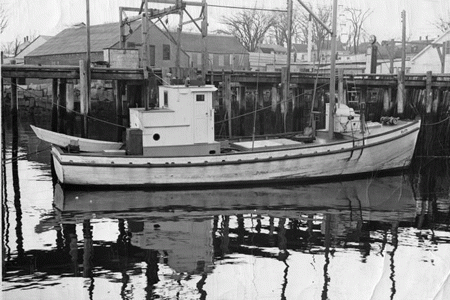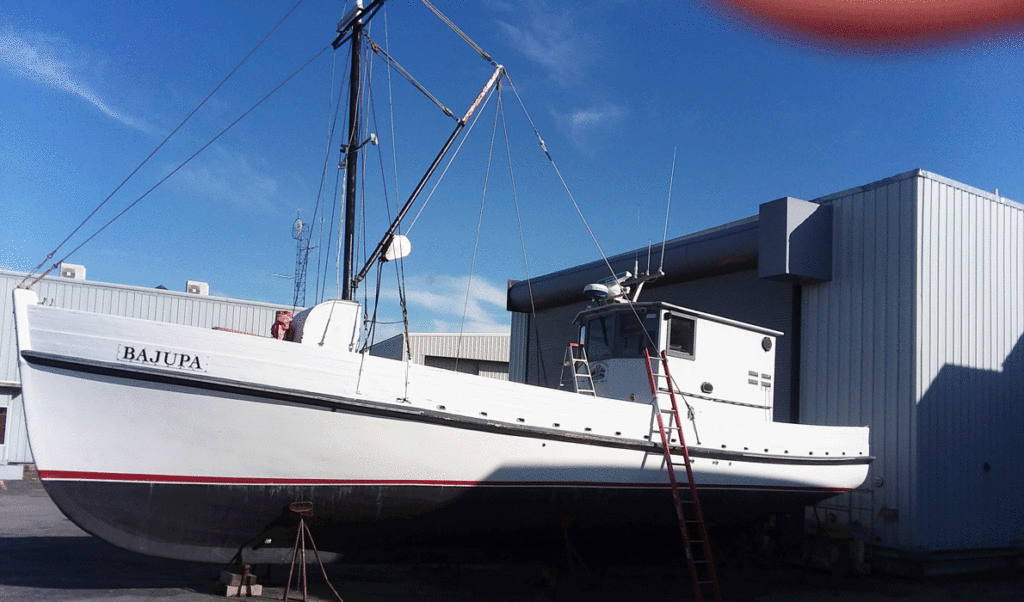This story first appeared in Landings,the monthly publication of the Maine Lobstermen’s Community Alliance, and appears here with permission.
By Melissa Waterman
It’s rare to find a boat that nearly every fisherman would term “pretty,” but in the case of Bajupa, that phrase rings true. Built in 1946 by Robert Rich, proprietor of Bass Harbor Boat Company, as a lobster smack for the Rackliff and Witham Lobster Company of Rockland, the 50-foot Bajupa has made the trip between the city and Matinicus Island for many years under the command of half a dozen men. This summer she’s taking a slightly different route, between Rockland and North Haven.
Lobster smacks once plied the coast, carrying fuel and bait to fishing islands and the fishermen’s catches back to the mainland. According to the University of Maine, the first smacks were sailing vessels that had wells within them filled with seawater, which kept seafood alive during transport.
In the 1830s, Elisha Oakes of Harpswell was the first Mainer to use smacks to carry live lobster to Boston and New York. These vessels had holes bored in the hull to allow fresh seawater to pass through and hatch covers on deck, to ensure that no fresh rainwater entered the well. Eventually smacks gained engines and refrigeration and the wet wells faded into history.
BAJUPA IS BORN
In 1946, Jim Pease, general manager at Rackliff and Witham Lobster Co., wanted a sturdy, seaworthy boat for his lobster trade. He talked design over with Rich and settled on a traditional dragger hull but one widened slightly to accommodate its cargo.
“She was southern white pine on oak,” said Martin Molloy, the current owner of the boat. “The design is a one-off. There’s not another boat like her.” Molloy purchased Bajupa, which took its name from the first two letters of Pease’s three daughters, Barbara, Judy and Patricia, in 2000 from Mark Ames of Matinicus.
Each year Molloy would have the boat hauled at O’Hara’s yard in Rockland and inspected. In 2005, 16 starboard side ribs were found to be largely gone. “We vacuumed them out of there,” he said, shaking his head.
She received new ribs and was fiberglassed over, 16 layers in all, and a new 300 horsepower John Deere engine installed.
“And she held her shape, those old-fashioned lines,” Molloy said.
Bajupawas built to move large amounts of weight but she does it with style and with safety. The vessel can carry 50 barrels of herring, two pallets of frozen bait, 250 empty lobster crates, and 700 gallons of fuel.
“I tell people, ‘She goes often, but she doesn’t go fast,’” Molloy said.
Many men have been involved with Bajupa over the course of her 72-year life. Molloy ticked off various past owners. “Jim Pease would run through the Fox Islands. Sometimes he’d take his daughters with him. They would go swimming from the boat and all the fishermen would come out to watch,” he laughed.
Arthur Hupper, a St. George fisherman who lobstered from Criehaven, operated Bajupaas part of his lobster buying business, Art’s Lobster. Eddie Ausplund later bought Hupper’s business and the vessel as well.
MATINICUS CONNECTION
To a Matinicus resident, Bajupa was more than just a way to move bait and lobster between the island and the mainland.
“From my perspective, Bajupa provides all of the services required to buy lobsters anywhere. It transports catch, bait, crates, bands, and any other essential supplies,” Tad Miller, a Matinicus lobsterman, explained. “And there are always people who work or live on the island catching rides in or out on it too. In my mind, Bajupa is one reason that Matinicus has been able to maintain a year-round community.”
To successfully operate a lobster smack, no matter how nice her lines, one must be “patient and thick-skinned,” Molloy explained. “You are the go-between between the lobstermen and the dealers. You are the one they see if the price goes down. You listen to a lot of stuff but you can’t let it worry you.”
The smack also needs to move a high volume of lobster to offset maintenance, insurance, fuel, and other costs. When Molloy first started the run to Matinicus, Bajupa would head to the island from April to December. Now, as a consequence of the uptick in offshore lobstering throughout the year, Bajupa runs all year, with the bulk of its trips occurring from July through the winter into March.
Making the 25-cent margin he needs to be successful has gotten harder over the years, according to Molloy.
“Used to be we made money during seven or eight months of the year. Now you make money during four months and the other eight you don’t. There’s no volume in the winter and the lobsters offshore are shedding all the time. It’s different than it was,” he said.
This fall, Bajupa will be in slightly more kindly waters than her former route to Matinicus Island. Molloy is using a new boat, the 47-foot Liberty Risk 2, for the Matinicus run and settling Bajupa into a North Haven-Rockland route. “She’s getting older. This is sort of breathing new life into her. She always works. I would never sell her,” he said.

Bajupa in Bass Harbor





